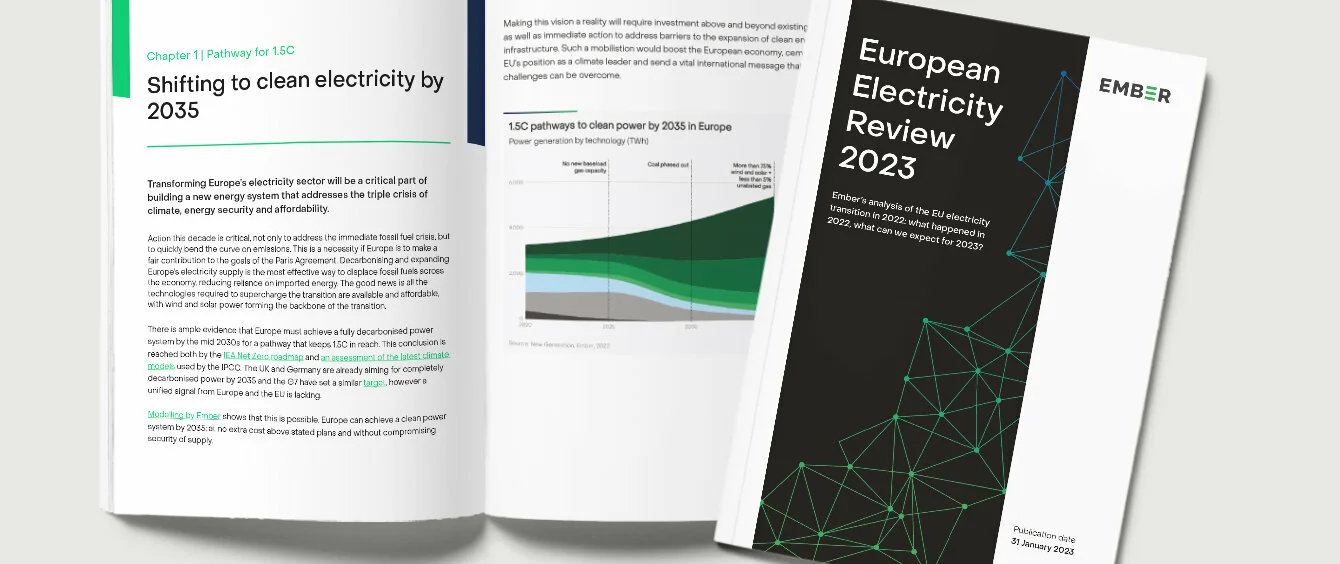Wind and solar generation combined accounted for 22% of EU electricity generation in 2022, outstripping gas-fired generation for the first time, according to the European Electricity Review 2023, published by environmental think tank Ember.
Yet EU power sector emissions still rose by 3.9%, as both gas and coal-fired power generation increased. What explains these contradictory trends, and what can we expect in 2023?
2022 was a tumultuous year
Energy markets worldwide reeled from the impact of Russia’s invasion of Ukraine and the sharp drop in Russia-Europe gas trade. Large-scale electricity demand conservation, driven by high prices, led to a 2.7% drop in overall EU electricity use, concentrated in the final quarter of the year.
However, while demand fell, a large gap in power supply was created by sharp drops in both nuclear – the EU’s single largest source of electricity — and hydro generation. Hydro output fell by 19% as much of Europe experienced extraordinary drought conditions. Nuclear generation dropped 16%, owing to plant closures and a large number of French reactors being offline for repairs and maintenance. The supply gap was met by a combination of increased fossil fuel use and renewables, excluding hydro. Solar generation jumped by a record 39 TWh, or 22%. Wind generation rose by 33 TWh, up 8.6%, while coal and gas-fired generation rose by 7% and 0.8% respectively.
Fossil fuel generation could fall sharply this year
Ember is predicting a comeback for both hydro and nuclear power this year, which, with continued gains in solar and wind capacity, would mean a big squeeze on fossil power and a subsequent welcome drop in power sector emissions.
Could it happen?
Hydro power is a consistent baseload power supplier – if there is plenty of water. However, as in 2022, output can vary substantially from year to year. In addition, climate change is expected to make hydro generation more variable, owing to increased incidence of floods and droughts. WWF published a study of the risks associated with climate change and existing hydro dams.
For 2023, the outlook looks better than in 2022, but there are still uncertainties – not least the weather over the remainder of the year. Reservoir levels in January remained low compared with 2021 in the Nordic countries and in Italy, although they have recovered remarkably well in the Alps and Iberian Peninsula.
Nuclear’s comeback is also no given and as nuclear plants are generally large generators, outages have a big impact on supply.
Nuclear energy uncertainty
Germany last year extended the closure of its last three nuclear plants until April 2023. If that deadline is maintained, then the EU’s nuclear fleet will decrease this year. Belgium also closed a reactor near Antwerp last September and its Tihange 2 unit on January 31 this year.
French nuclear generation, the largest in Europe by some margin, remained 17.5% below the 2020-21 average in January, and, although output is expected to recover, the need for repairs and upgrades to the country’s increasingly aged fleet suggest generation will struggle to match 2021.
Wind and solar are powering ahead
What is more certain is that, despite still slow permitting times and supply chain issues, developers, like RWE Renewables, are continuing to deliver successfully new solar and wind capacity. Solar Power Europe, for example, forecasts that solar PV capacity in the EU will grow by more than 50 GW this year, up from last year’s record new additions of 41.4 GW.
Similarly, the Windpower Intelligence Global Forecast expects 19.4 GW of new wind capacity will be completed in Europe in 2023, up from 16.9 GW last year, followed by 22.7 GW in 2024.
Demand bounce back could upset forecast
As a result, the return of hydro and nuclear, combined with accelerating deployments of wind and solar, should all serve to put the squeeze on both coal and gas-fired generation. Ember says fossil fuel generation could plummet by 20% this year, more than reversing last year’s increases.
However, in addition to the uncertainties governing the hydro and nuclear sectors, other key variables remain in play. One is the degree to which demand bounces back from a tough year in 2022. Recent economic forecasts have brightened in the wake of China’s removal of its zero-tolerance Covid policies. Another is the Ukraine war, which will keep security of supply issues to the fore.
So what will 2023 bring? More clean power in the form of wind and solar for sure, but whether this translates into a large drop in power sector fossil fuel use … only time will tell.
